碳交易环境下政府循环率规制对生产者尽规模式的影响机理
2020-09-09陈玉玉李帮义柏庆国
陈玉玉,李帮义,柏庆国,王 哲,王 玥,周 扬
碳交易环境下政府循环率规制对生产者尽规模式的影响机理
陈玉玉1,李帮义1,柏庆国2,王 哲1,王 玥1,周 扬1
(1. 南京航天航空大学 经济与管理学院,江苏 南京 211106; 2.曲阜师范大学 管理学院、运筹学研究院,山东 日照 276826)
绿色发展要求生产者承担节能减排和回收、循环并再利用的责任。碳限额交易政策既约束生产者的行为又诱导生产者生产方式的转变。循环率规制政策赋予生产者对废旧电子电器设备(WEEE)循环利用的责任。基于碳交易环境,文章首先研究循环率规制约束下生产者尽规模式的选择,然后探究面对愈加严格的法律法规,生产者实现尽规的方式,最后分析政府制定的循环率目标对社会福利的影响。研究结果表明,生产者有三种尽规模式可选择,并得到其阈值;面对不断严格的规制要求,生产者可以通过增加再制造品的产量、减少减排投资和新产品产量的方式实现尽规;研究还发现随着政府规制要求的提高,生产者利润减少,但这并不意味着消费者剩余一定减少,并且环境影响随着循环率目标的提高有可能反而增大,即并非循环率目标越高对环境越有利。
再制造;循环率规制;碳限额交易政策;减排投资;尽规模式
0 引言
减少碳排放量和实现资源循环利用已成为学者们关注的热点话题。随着科技水平的不断提高,极大丰富了人类物质生活水平,废旧电子电器设备(Waste Electrical and Electronic Equipment, WEEE)的数量也急剧增加。据统计,2014年全球WEEE总数高达4180万吨,预计2018年可达5000万吨[1]。WEEE产品内含有大量的重金属和化学有毒物质,如果得不到有效处置,将会对环境产生恶劣的影响。另一方面,WEEE的回收处理,可以节约制造成本和实现资源循环利用。在WEEE循环再利用的众多方式中,再制造无论从环境还是从资源的角度,都是最佳的商业化方式。目前华为、IBM和苹果等国际知名企业已经参与到再制造中,并以此获取经济利益和实现社会责任。
如何提高回收循环率,实现再制造目标,引起了政府和理论研究者的广泛关注。许多国家和地区已经通过颁布法律法规提高WEEE产品的回收和循环率,如欧盟WEEE指令、日本的特定家用电器回收法(SHARL)等[2],简称循环率规制。2016年底,我国颁布的《生产者责任延伸制度推行方案》指出,到2020年包括电子电气产品在内的重点品种的废旧产品的规范回收和循环使用率达到40%,2025年实现50%的目标[3]。面对政府所制定的强制性法规,生产者将如何进行决策(即如何选择尽规模式),不断严格的法规将对生产者决策有何影响,这便是本文将要回答的问题。
另一方面,全球气温升高,减少碳排放量成为企业必须履行的社会责任之一。政府通过颁布限额政策、碳税政策和碳限额交易政策等法律法规来减少碳排放量[4]。其中,碳限额交易政策是以市场为基础较有效的减排机制之一,并已经在许多国家实施[5]。截止到2015年4月1日,全球范围内相继建成17个碳交易体系,碳交易成交总额高达340亿美元,占全球GDP的40%。我国也已经在7个城市设立碳交易试点,并取得良好效果。
闭环供应链是循环与再商业化责任在生产运作层面的实现方式。国内外学者在再制造和闭环供应链领域进行了积极的探索,Ferrer等[6]假设新产品和再制造品无差异,分别研究了有无竞争时新、再制造品的定价问题。Ferrer等[7]进一步将研究推广至新产品和再制造产品差异化定价的情形。徐峰等[8]基于消费者对新产品和再制造品具有不同的支付意愿,对单一定价和差异化定价两种策略进行比较。
已有研究虽然在制造/再制造生产决策的研究方面取得了一定成果,但并没有考虑碳排放及减排投资,也未考虑政府循环率规制在企业再制造生产决策的影响,而本文正是将其结合进行研究。与本文相关的研究文献主要包括两个方面:碳限额交易政策、WEEE回收法规约束下企业回收再制造行为的优化决策。
碳排放不仅可以作为一个评价环境的重要指标,而且将通过碳交易和改变消费者需求的方式最终影响生产者的利润,因此越来越多的学者对制造/再制造生产决策问题研究中考虑了碳排放。Yenipazarli[9]研究了碳税政策下,同时参与新产品和再制造品制造的寡头垄断生产商的最优生产和定价决策问题,并分别分析了碳税与碳交易政策对战略决策的影响。Liua等[10]研究了随机环境下,碳限额、碳交易、碳税三种碳政策对再制造生产决策的影响。Wang等[11]研究生产商的碳排放约束和资金约束下的制造/再制造决策问题。Chang等[12]研究了碳限额交易政策下寡头垄断生产商面对独立需求市场和替代需求市场时新产品与再制造品的生产决策。聂佳佳等[13]研究了碳限额交易政策对零售商负责回收闭环供应链的定价策略和回收策略的影响。基于碳限额交易政策,Fahimnia等[14]通过与标准正向供应链进行比较,分析碳定价对闭环供应链的影响。Miao等[15]分别基于碳税政策和碳限额交易政策,分析考虑以旧换新时制造商的最优定价和制造/再制造决策。王文宾等[16]对碳排放约束下制造商竞争的逆向供应链政府奖惩机制进行研究。
关于WEEE回收法规的研究主要解决两个问题:合规计划的设计(政府层面)和尽规模式的选择(生产者层面)。
政府层面,决定生产者的量化回收责任并设计成可执行、可验证的规定制度。如,欧盟WEEE指令规定2016年生产者最低回收率为45%,日本特定家用电器回收法(SHARL)规定循环和再制造率在50%-60%之间[2]。合规计划(Compliance Schemes)是指将EPR立法转化成环境绩效。
生产者层面,生产者面临着复杂决策以实现政府的规制要求,如生产决策(通过碳交易市场)、价值恢复决策(再制造)和回收决策。尽规(Due Diligence)指生产者尽最大的能力、配置必要的资源,以实现立法的要求。尽规模式就是回答生产者责任实现情况,即对政府规制的实现状况和程度。
目前,对于生产者尽规模式选择的研究正在兴起,而本文也是对生产者尽规模式选择进行研究。Webster等[17]研究包含单个生产者和单个再制造商的两周期决策模型,其中生产者不从事再制造,通过数值实验分析了回收法规对企业利润和再制造决策的影响。Esenduran等[18]考虑存在再制造商的竞争,生产者同时生产新产品和再制造,分析回收法规和双方竞争对再制造水平和环境的影响。而本文重点研究回收规制政策对垄断生产者的再制造决策的影响,故不考虑竞争情形。和本文研究背景类似,Karakayali等[19]探究了是否应该将再利用目标纳入回收目标,Esenduran等[2]分析了回收法规对再制造和环境的影响。关于合规计划设计的研究较多,相关文献见Esenduran等[20, 21]、Atasu等[22-24]和Jacobs等[25]。
政府不仅需要对企业生产环节中的碳排放量进行监管,还需要对消费环节WEEE的循环利用进行引导。现有文献虽然已经对生产环节的碳排放量和销售环节的循环率规制分别进行研究,但并没有学者将生产和销售两个环节进行结合。若政府即对生产者生产环节的碳排放量进行引导又对销售环节的循环行为进行规制,生产者的生产决策将如何让变化,生产者将如何选择尽规模式。
基于上述分析,本文在企业制造/再制造生产决策中引入碳限额交易政策和循环率规制政策。基于碳交易环境,构建生产者制造/再制造最优生产决策模型,探究循环率规制政策下生产者尽规模式的选择以及循环率目标的不断提高对生产者决策及其利润的影响。
1 问题描述和符号介绍
1.1 问题描述



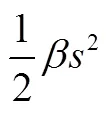

图1 模型基本思路图
Figure 1 Basic idea of the model
模型的基本思路如图1所示,单寡头垄断生产者同时生产新产品和回收WEEE进行再制造。政府通过颁布循环率规制政策和碳限额交易政策分别对消费环节的循环率以及生产环节的碳排放量进行规制和引导。在政府双重规制约束下,考虑消费者偏好时,生产者决定对新、再制造品的生产计划以及碳减排的投资决策。
进行减排投资不仅会产生环境成本,而且会影响市场需求,最终导致生产者利润的变化,因此本文基于碳交易环境和减排投资,考虑新产品和再制造品的异质替代性,分别探究两种情形:(1)不考虑循环率规制,记作模式NR (No Regulation);(2)考虑循环率规制,记作模式R (Regulation)。通过对两种情形下生产者最优决策进行比较,分析循环率规制对生产者尽规模式的影响机理。然后探究随着政府规制要求的提高,生产者实现尽规的方式是怎样的,以及不断严格的规制要求对社会福利(包括生产者利润、消费者剩余和碳排放量)的影响。
1.2 符号系统
文中符号说明如表1所示,其中上标R (Regulation)和NR (No Regulation)分别表示有、无循环率规制政策。
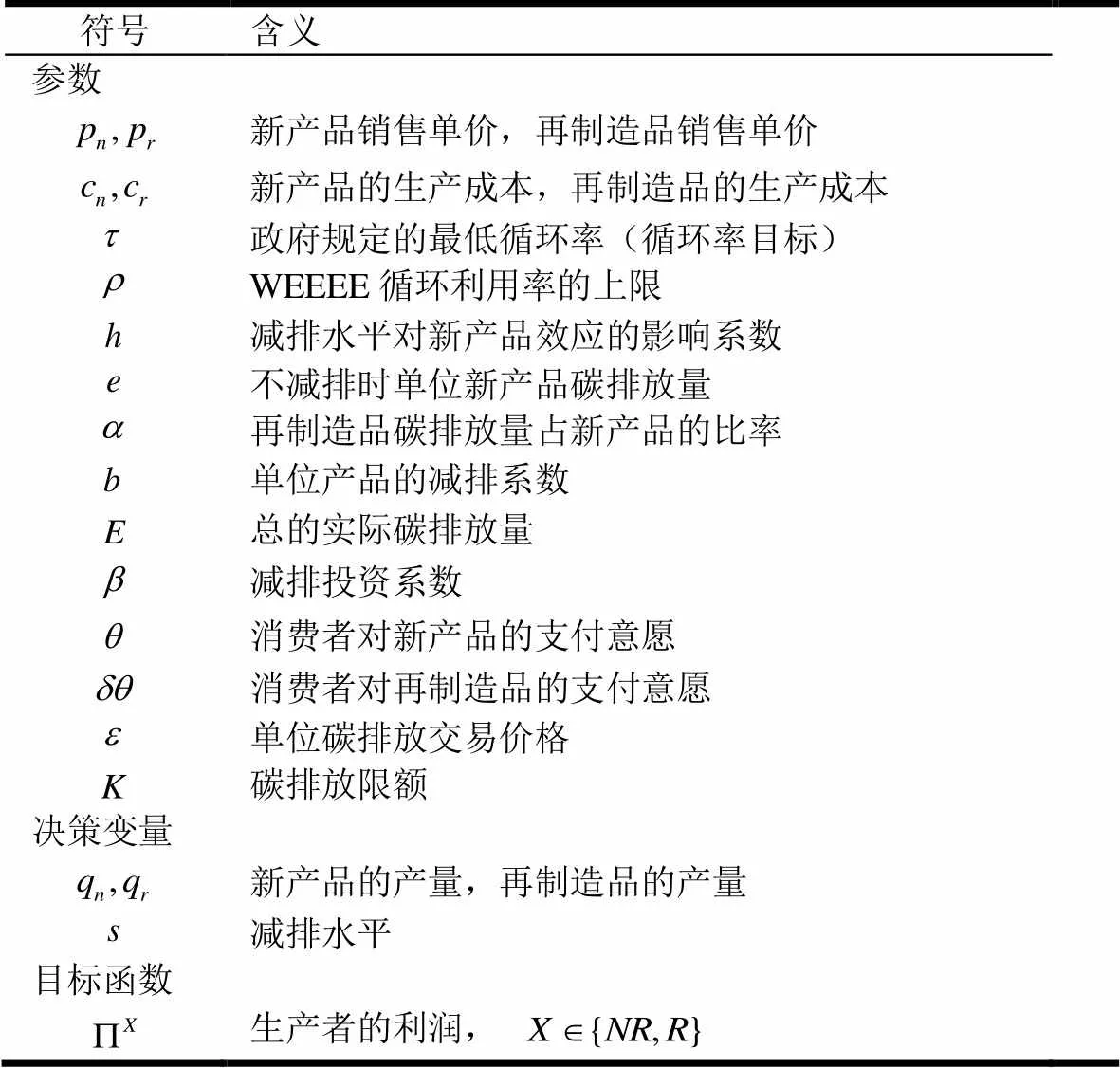
表1 符号说明

1.3 减排约束下的市场结构

图2 消费者行为导向的市场结构
Figure 2 Consumer-oriented market structure
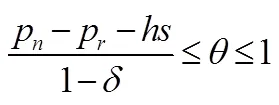

2 生产者生产决策驱动的尽规模式分析
生产者基于效益驱动的决策:

2.1 无循环率规制时的最优决策(NR)


图3 无循环率规制时的最优方案
Figure 3 Optimal solution without recycling rate regulation
推论1表明只有当再制造品具有一定的竞争优势时,生产者才会进入再制造市场。
2.2 有循环率规制时的最优决策(R)
下面研究循环率规制约束下生产者尽规模式的选择。
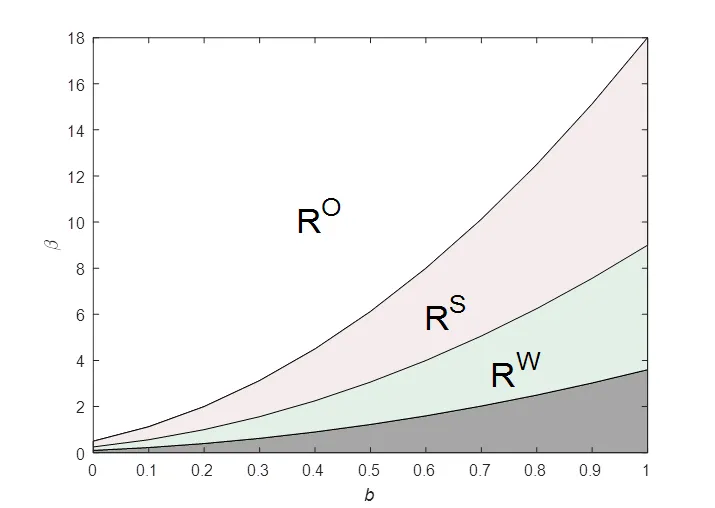
图4 有循环率规制时的最优方案
Figure 4 Optimal solution with recycling rate regulation

表2 生产者的最优决策
3 政府循环率目标的影响分析
世界各地的循环率规制的要求越来越严格,循环率目标不断提高。不断严格的循环率规制又将产生何种影响?
3.1 循环率目标对生产者决策的影响
3.2 循环率目标对社会福利的影响
循环率规制的目标是将WEEE的处理责任由政府转移给生产者,而生产者通常会对价格的调整又将责任转移给消费者,最终导致消费者剩余的降低,然而研究表明并非总是如此。为充分理解这种影响,下面分析生产者利润和消费者剩余随循环率目标的变化情况。消费者剩余(Consumer Surplus, CS)为购买新产品的消费者剩余与购买再制造产品的消费者剩余之和:



下面分析循环率目标的提高对环境(碳排放量)的影响,生产者生产过程中的碳排放总量:

4 数值分析

图5 最优决策变量随对最优决策变量的影响

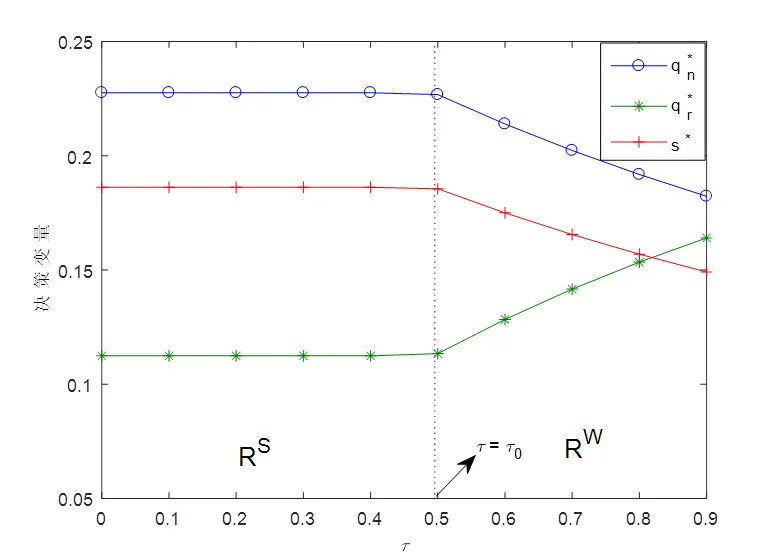
图6 对最优决策变量的影响

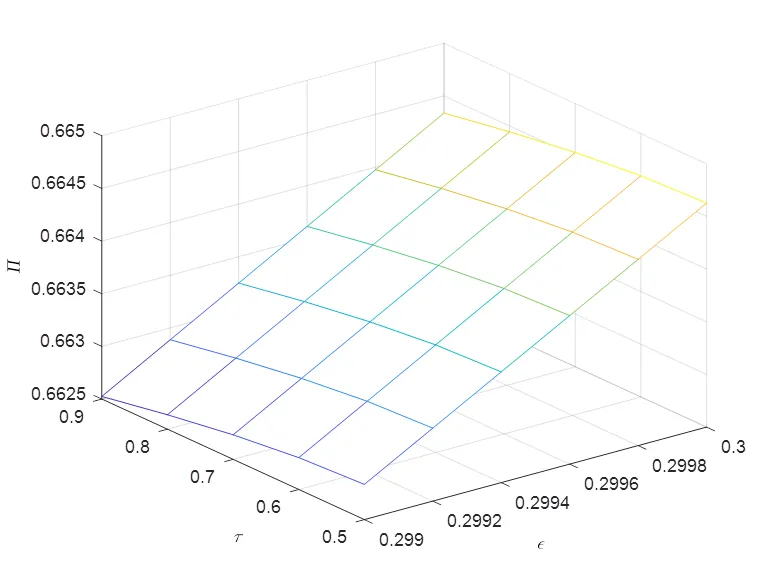
图7 和对生产者利润的影响

5 结论与展望
一方面,随着废旧WEEE数量的急剧增加,政府赋予生产者对WEEE循环利用的责任,并颁布法律对生产者回收再利用行为进行规制;另一方面,节能减排是当今的重要话题,在碳限额交易政策的压力下,企业将选择进行减排投资。本文在企业制造/再制造生产决策中引入循环率规制和碳限额交易政策。基于寡头垄断生产者利润最大化,构建集成碳限额交易和循环率规制约束的生产者制造/再制造最优决策模型,探讨生产者尽规模式的选择以及循环率目标对生产者决策和社会福利的影响。
研究发现:生产者有三种尽规模式可选择,并得到其阈值;随着循环率目标提高,生产者将通过减少减排投资、减少新产品产量和扩大再制造品生产规模的方式实现尽规,最终将导致生产者利润减少,但是循环率目标提高并不一定会导致消费者剩余的减少和对环境影响的降低。
本文研究的是碳限额交易政策和循环率规制政策约束下完全垄断生产者尽规模式的选择,即仅考虑了生产者内部竞争的情形。自然地,可考虑外部竞争,竞争环境下尽规模式影响机理将更复杂,笔者将对此做进一步研究。
[1] Baldé K, Wang F, Kuehr R, et al. The Global E-waste Monitor[M]. UNU-IAS: Bonn, Germany. 2015.
[2] Esenduran G, Kemahlıoğlu Ziya E, Swaminathan J M. Take-Back Legislation: Consequences for Remanufacturing and Environment[J]. Decision Sciences. 2016, 47(2): 219-256.
[3] 国务院办公厅关于印发生产者责任延伸制度推行方案的通知[J]. 再生资源与循环经济,2017,10(01):1-3.
State Council on the Issuance of Extended Producer Responsibility System Implementation Plan[J]. Renewable resources and circular economy. 2017,10(01):1-3.
[4] Song J, Leng M. Analysis of the Single-Period Problem under Carbon Emissions Policies[M]. Springer New York, 2012: 297-313.
[5] 柏庆国,徐贤浩. 碳限额与交易政策下易变质产品的最优库存策略[J]. 中国管理科学. 2017, 25(07): 28-37.
Bai Q G, XU X H. OptimalInventoryPolicyforDeterioratingItemsUnderCap-and-trade Regulation[J]. Chinese Management Science, 2017, 25(07): 28-37.
[6] Ferrer G, Swaminathan J M. Managing New and Remanufactured Products[J]. Management Science. 2006, 52(1): 15-26.
[7] Ferrer G, Swaminathan J M. Managing new and differentiated remanufactured products[J]. European Journal of Operational Research. 2010, 203(2): 370-379.
[8] 徐峰,盛昭瀚,陈国华. 基于异质性消费群体的再制造产品的定价策略研究[J]. 中国管理科学. 2008, 16(06): 130-136.
Xu F, Sheng Z H, Chen G H. The Remanufactured Products Pricing Strategy in a Heterogeneous Market[J]. Chinese Journal of Management Science, 2008,16(06): 130-136.
[9] Yenipazarli A. Managing new and remanufactured products to mitigate environmental damage under emissions regulation[J]. European Journal of Operational Research. 2016, 249(1): 117-130.
[10] Liu B, Holmbom M, Segerstedt A, et al. Effects of carbon emission regulations on remanufacturing decisions with limited information of demand distribution[J]. International Journal of Production Research. 2015, 53: 532-548.
[11] Wang Y, Chen W, Liu B. Manufacturing/remanufacturing decisions for a capital-constrained manufacturer considering carbon emission cap and trade[J]. Journal of Cleaner Production. 2017, 140: 1118-1128.
[12] Chang X, Xia H, Zhu H, et al. Production decisions in a hybrid manufacturing-remanufacturing system with carbon cap and trade mechanism[J]. International Journal of Production Economics. 2015, 162: 160-173.
[13] 聂佳佳,王拓,赵映雪,等. 碳排放约束下再制造闭环供应链回收策略[J]. 管理工程学报. 2015, 29(03): 249-256.
Nie J J, Wang T, Zhao Y X, et al. Collecting Strategies for the Closed-loop Supply Chain with Remanufacturing in the Constraint of Carbon Emission[J]. Journal of Industrial Engineering and Engineering Management, 2015, 29(03): 249-256.
[14] Fahimnia B, Sarkis J, Dehghanian F, et al. The impact of carbon pricing on a closed-loop supply chain: an Australian case study[J]. Journal of Cleaner Production. 2013, 59: 210-225.
[15] Miao Z, Mao H, Fu K, et al. Remanufacturing with trade-ins under carbon regulations[J]. Computers & Operations Research. 2018, 89: 253-268.
[16] 王文宾,邓雯雯,白拓,等. 碳排放约束下制造商竞争的逆向供应链政府奖惩机制研究[J]. 管理工程学报. 2016, 30(02): 188-194.
Wang W B, Deng W W, Bai T, et al. Design the Reward-penalty Mechanism for Reverse Supply Chains Based on Manufacturers’Competition and Carbon Footprint Constraints[J]. Journal of Industrial Engineering and Engineering Management, 2016, 30(02): 188-194.
[17] Webster S, Mitra S. Competitive strategy in remanufacturing and the impact of take-back laws[J]. Journal of Operations Management. 2007, 25(6): 1123-1140.
[18] Esenduran G, Kemahlıoğlu-Ziya E, Swaminathan J M. Impact of Take-Back Regulation on the Remanufacturing Industry[J]. Production and Operations Management. 2017, 26(5): 924-944.
[19] Karakayali I, Boyacı T, Verter V, et al. On the Incorporation of Remanufacturing in Recovery Targets[J]. Desautels Faculty of Management, McGill University. 2011.
[20] Esenduran G, Atasu A, Van Wassenhove L N. Valuable E-Waste: Implications for Extended Producer Responsibility[J]. Social Science Electronic Publishing. 2015.
[21] Esenduran G, Kemahlıoğlu-Ziya E. A Comparison of Product Take-Back Compliance Schemes[J]. Production and Operations Management. 2015, 24(1): 71-88.
[22] Atalay A, Van W L N, Miklos S. Efficient Take-Back Legislation[J]. Production and Operations Management. 2009, 18(3): 243-258.
[23] Atasu A, Özdemir Ö, Van Wassenhove L N. Stakeholder Perspectives on E-Waste Take-Back Legislation[J]. Production and Operations Management. 2013, 22(2): 382-396.
[24] Atasu A, Subramanian R. Extended Producer Responsibility for E-Waste: Individual or Collective Producer Responsibility?[J]. Production and Operations Management. 2012, 21(6): 1042-1059.
[25] Jacobs B W, Subramanian R. Sharing Responsibility for Product Recovery Across the Supply Chain[J]. Production and Operations Management. 2012, 21(1): 85-100.
[26] Dong C, Shen B, Chow P, et al. Sustainability investment under cap-and-trade regulation[J]. Annals of Operations Research. 2016, 240(2): 509-531.
[27] Bai Q, Chen M, Xu L. Revenue and promotional cost-sharing contract versus two-part tariff contract in coordinating sustainable supply chain systems with deteriorating items[J]. International Journal of Production Economics. 2017, 187: 85-101.
[28] Swami S, Shah J. Channel Coordination in Green Supply Chain Management[J]. Journal of the Operational Research Society. 2013, 64(3): 336-351.
[29] Xu J, Chen Y, Bai Q. A two-echelon sustainable supply chain coordination under cap-and-trade regulation[J]. Journal of Cleaner Production. 2016, 135: 42-56.
The impacts of recycling rate regulation on due diligence patterns of producer under carbon trading environment
CHEN Yuyu1, LI Bangyi1, BAI Qingguo2, WANG Zhe1, WANG Yue1, ZHOU Yang1
(1. College of Economics and Management, Nanjing University of Aeronautics and Astronautics, Nanjing 211106, China; 2. School of Management, Institute of Operations Research, Qufu Normal University, Rizhao 276826, China)
Green development requires producers to take responsibility for energy conservation, emission reduction, recycling, and reuse. The carbon cap-and-trade regulation not only constrains producers’ behavior, but also induces the transformation of producers’ production methods. The recycling rate regulation forces producers to take responsibility for the recycling and reuse of Waste Electrical and Electronic Equipment (WEEE).
Although the existing literature has separately studied carbon emission and WEEE recycling based on the carbon cap-and-trade regulation in the production process, no scholars have considered in tandem the two sides of production and sales. The government not only needs to regulate carbon emissions in the production process, but also needs to guide the recycling of WEEE at the end of its useful life.
This paper introduces carbon cap-and-trade and recycling rate regulation policies into manufacturing/remanufacturing production decisions, in consideration of sustainable and emissions-reducing investment. With the objective of maximizing the profit of monopolist producers, we construct the optimal production decision model of producers under carbon cap-and trade and recycling rate regulation, and explore the producers' choice of due diligence patterns as well as analyze the impact of the recycling rate target on the producer decision-making process and social welfare. Finally, the theoretical results are verified by a case study.

Part 2 explores the increasingly strict laws and regulations and the way they influence how producers achieve due diligence, and analyzes the impact of higher recycling rate targets on social welfare. The study finds that, in the face of increasingly stringent laws and regulations, producers can achieve due diligence by limiting sustainable and emissions-reducing investments, limiting production of new products, and expanding the scale of production of remanufactured products; it also finds that, as the recycling rate target increases, the profit of producers decreases. But this does not mean a reduction in consumer surplus and a reduction in environmental impact. Specifically, producers will shift responsibility to consumers by adjusting prices, which ultimately leads to a reduction in consumer surplus, although we find that this is not always the case. More importantly, when carbon emissions in the remanufacturing process are high, an increase in the recycling rate target may lead to an increase in environmental impact.
In summary, when producers make manufacturing/remanufacturing production decisions based on recycling rate regulations, it is important for them to consider carbon emissions, as doing so will help them generate more profit. In addition, the government should pay more attention to potential unintended consequences when raising the recycling rate target.
Remanufacturing; Recycling rate regulation; Cap-and-trade regulation; Sustainability investment; Due diligence patterns
2017-11-27
2018-06-02
The work was supported by National Natural Science Foundation of China (71771138, 71702087), the Fundamental Research Funds for the Central Universities (NP2016303, NS2017057) and the Funding of Jiangsu Innovation Program for Graduate Education (KYCX18_0236)
F253
A
1004-6062(2020)04-0154-007
10.13587/j.cnki.jieem.2020.04.017
2017-11-27
2018-06-02
国家自然科学基金资助项目(71771138、71702087);中央高校基本科研业务费专项资金资助项目(NP2016303、NS2017057);江苏省普通高校研究生科研创新计划项目(KYCX18_0236)
陈玉玉(1990—),女,山东济宁人;南京航空航天大学经济与管理学院,博士生;研究方向:运作管理,生产者责任延伸机制。
中文编辑:杜 健;英文编辑:Boping Yan
